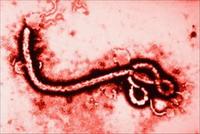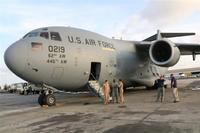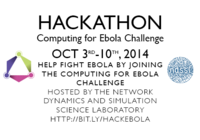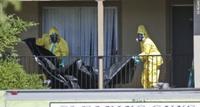-
IAEA to provide nuclear detection technology to help diagnose Ebola in West Africa
The International Atomic Energy Agency (IAEA) said it would provide specialized diagnostic equipment to help Sierra Leone in its efforts to combat the Ebola Virus Disease (EVD) outbreak. Later, the support is planned to be extended to Liberia and Guinea. The support is in line with a UN Security Council appeal and responds to a request from Sierra Leone. The IAEA assistance will supplement the country’s ability to diagnose EVD quickly using a diagnostic technology known as Reverse Transcriptase Polymerase Chain Reaction (RT-PCR). RT-PCR is a nuclear-derived technology which allows EVD to be detected within a few hours, while other methods require growing on a cell culture for several days before a diagnosis is determined.
-
-
How are nurses becoming infected with Ebola?
WHO, CDC, and health authorities in many countries recommend health workers treating Ebola wear surgical masks for protection, along with other personal protective equipment such gowns, gloves, and goggles. A glaring inconsistency of these guidelines is that lab scientists working with Ebola are recommended to use respirators, which offer more protection than surgical masks, while masks are deemed adequate for doctors and nurses at the front line. The hospital ward, however, is a far more contaminated and volatile environment than the sterile, highly controlled lab, and nurses have the closest contact with patients, and deserve all available protection for their occupational health and safety. In most responses, lack of knowledge about infection control may not be critical, but in the case of Ebola it may cost lives. The price of getting it wrong with flu guidelines might be a week in bed, but for Ebola it is far more likely to be death. The risk analysis equation we need to use must consider not only the probability of Ebola turning up on our shores, but also the consequences.
-
-
U.S. seeking innovative solutions for protecting healthcare workers on Ebola front lines
The U.S. Agency for International Development (USAID) has issued a Broad Agency Announcement (BAA), saying the agency is looking for opportunities to co-create, co-design, co-invest, and otherwise collaborate in the development, testing, and scaling of practical and cost-effective innovations to help healthcare workers on the front lines provide better care and stop the spread of Ebola. USAID notes that this funding mechanism will not support research that does not provide a clear path to development and testing of prevention and intervention strategies. Awards are in the range of $100,000 to $1million.
-
-
New tool can be used as a universal Ebola drug target

University of Utah biochemists have reported a new drug discovery tool against the Ebola virus. According to a study published in this week’s online edition of Protein Science, they have produced a molecule, known as a peptide mimic, which displays a functionally critical region of the virus that is universally conserved in all known species of Ebola. This new tool can be used as a drug target in the discovery of anti-Ebola agents which are effective against all known strains and likely future strains. The same group of biochemists has previously developed highly potent and broadly acting D-peptide inhibitors of HIV entry, currently in preclinical studies, and is now adapting this approach to Ebola using the mimics developed in this study.
-
-
CDC chief: U.S. “rethinking” Ebola strategy after Dallas nurse’s infection
U.S. federal health officials have urged hospitals to “think Ebola” as officials in Texas are anxiously trying to identify all staff involved in the care of America’s patient zero following the news that a nurse — Nina Pham, 26 — who was involved in his care is the first person to contract the disease in the United States. “We have to rethink the way we address Ebola infection and control because even a single infection is unacceptable,” Tom Frieden, director of the CDC, said on Monday. CDC officials are now watching the Dallas hospital personnel as they put on and take off their protective garb, retraining the staff and evaluating the type of protective equipment being used. The CDC officials were considering using cleaning products that kill the virus to spray down workers who come out of the isolation unit where the nurse is being treated. CDC will update its infection control guidance document, mostly likely next week. The agency’s guidance is just that – a guidance – since the agency does not have the authority to compel hospitals to follow its recommended procedures.
-
-
Ebola vaccine trials begin in Mali
The Center for Vaccine Development (CVD) at the University of Maryland School of Medicine (UM SOM), in conjunction with the Center for Vaccine Development of Mali (CVD-Mali) and the Ministry of Health of Mali, have begun a clinical trial in health care workers (and other front-line workers) to evaluate a promising experimental Ebola vaccine. The trial began on Wednesday, 8 October, with the vaccination of the first subject, followed by two additional participants on 9 October — all three being Malian health care workers. In the coming weeks, thirty-seven more health care workers will receive the vaccine.
-
-
The mathematics of the Ebola epidemic
The Ebola epidemic in West Africa appears to be spiraling out of control. Local and global health authorities want to know how the epidemic will develop and, above all, how to prevent it from spreading further. Certain parameters help them to determine this, such as the reproductive number, which is the average number of infections caused by a single infected individual. Researchers, using the data available – for example, gene sequence of the virus in various patient samples — have calculated that in the current outbreak, the viral reproductive number is 2.18: Every infected individual on average causes 2.18 additional infections.
-
-
Pentagon’s medical countermeasures helpful in fighting Ebola outbreak
The U.S. Defense Department is better prepared to help with the West Africa Ebola outbreak because it has accelerated aspects of its medical countermeasures program established to protect troops from biological warfare agents, Andrew C. Weber, assistant secretary of defense for Nuclear, Chemical and Biological Defense Programs said the other day. “Ebola has always been on the threat list of agents that we’re concerned about,” Weber said, adding that DoD and the Department of Health and Human Services have been the only investors in medical countermeasures for such historically rare contagions as Ebola virus disease. Among the products whose development or availability the department has accelerated in response to the outbreak in West Africa is a vaccine against the Zaire strain of Ebola that is causing the epidemic.
-
-
U.S. to commit 4,000 soldiers, $750 million in the next six months to fight Ebola in Africa

The Pentagon’s effort to help eradicate Ebola in West Africa will require roughly 4,000 American soldiers, cost $750 million for the next six months, and may last longer than a year.American troops will help build seven testing labs and seventeen treatment facilities by mid-November, but troops will be on the ground in Liberia for at least a year.A majority of U.S. soldiers will not come in direct contact with Ebola patients, but a few dozen troops trained to operate in nuclear, biological, and chemical environments will be assigned to testing labs.
-
-
Texas officials question state preparedness for an outbreak
Following the death of Texas Ebola patient Thomas Duncan, many leaders in Texas are considering whether the state is prepared to handle a more wide scale public health emergency. The problem, analysts say, is that many local health departments in the state are run autonomously, and have split funding between local, state, and federal sources. As a result, they are not often all held to the same standard, and these disparities could be what would ultimately lead to disjointedness and failure to respond properly to an outbreak.
-
-
The U.S. is not at risk of an Ebola epidemic: Experts
The United States is highly unlikely to suffer an Ebola outbreak, according to the Centers for Disease Control and Prevention(CDC). Although U.S. hospitals have not had to deal with Ebola in the past, Western health institutions have studiedthe disease since it was first discovered in 1976 in Zaire, now the Democratic Republic of the Congo, positioning the CDC better to inform the public about Ebola, its symptoms, and how it spreads.
-
-
Computing for Ebola Challenge

Researchers at the Network Dynamics and Simulation Science Laboratory (NDSSL) have been using a combination of modeling techniques to predict the spread of the Ebola outbreak. As part of those efforts, the team created an adaptable set of global synthetic populations, allowing for rapid response as the situation continues to unfold. The synthetic populations and other informatics resources are now openly available to aid other researchers and citizen scientists. The NDSSL is hosting a Computing for Ebola Challenge from 3 October to 10 October 2014. The goal of the hackathon is to develop an application to combat the Ebola epidemic. All are welcome to join.
-
-
Candidates of both parties use Ebola crisis to attack opponents
Democratic and Republican campaign officials are uncertain about the political ramifications of Ebola’s arrival in the United States, but some congressional candidates have already used the topic to connect with voters. A poll by the National Republican Senatorial Committee(NRSC), the campaign group for Senate Republicans, found that 60 percent of voters believe Ebola should be treated as a major crisis by the White House if a single case of Ebola is found in the United States. Even congressional Democrats who have been supportive of Obama’s position toward the Ebola crises have used the Ebola epidemic against opponents.
-
-
CDC urges hospitals to follow Ebola-related protocols

The CDC had called for medical facilities to be on high-alert for Ebola-like symptoms, but these plans are only as effective as the practices of each hospital, and the recent Dallas case was marked by a mix-up at Texas Health Presbyterian Hospital. “We’re reiterating the message for every health worker in this country — think about travel history. If someone’s been in West Africa within twenty-one days and they’ve got a fever, immediately isolate them and get them tested for Ebola,” CDC director Thomas Frieden said.
-
-
Securiport’s advanced biometric immigration control systems help in fight against Ebola
Securiport says it is supporting the fight against the Ebola virus in West Africa by providing advanced biometric screening technologies and comprehensive contact tracing data analytics to help governments and health organizations monitor and control the spread of the virus. The company’s immigration control systems are now in place across a total of seven West African nations, including Sierra Leone, Senegal, and Ivory Coast.
-
- All
- Regional
- Water
- Biometrics
- Borders/Immig
- Business
- Cybersecurity
- Detection
- Disasters
- Government
- Infrastructure
- International
- Public health
- Public Safety
- Communication interoperabillity
- Emergency services
- Emergency medical services
- Fire
- First response
- IEDs
- Law Enforcement
- Law Enforcement Technology
- Military technology
- Nonlethal weapons
- Nuclear weapons
- Personal protection equipment
- Police
- Notification /alert systems
- Situational awareness
- Weapons systems
- Sci-Tech
- Sector Reports
- Surveillance
- Transportation
Advertising & Marketing: advertise@newswirepubs.com
Editorial: editor@newswirepubs.com
General: info@newswirepubs.com
2010-2011 © News Wire Publications, LLC News Wire Publications, LLC
220 Old Country Road | Suite 200 | Mineola | New York | 11501
Permissions and Policies
Editorial: editor@newswirepubs.com
General: info@newswirepubs.com
2010-2011 © News Wire Publications, LLC News Wire Publications, LLC
220 Old Country Road | Suite 200 | Mineola | New York | 11501
Permissions and Policies
